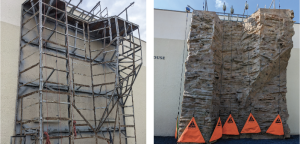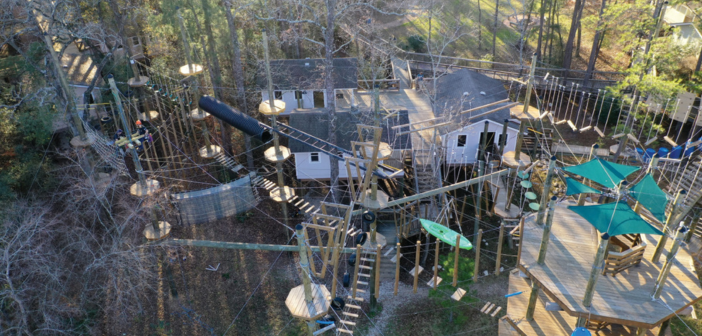Aerial activity builders have been extremely busy over the last few years, and the action shows no sign of letting up soon. Judging by the responses to API’s queries in the fall, it appears builders have created many new operations and made major modifications to existing operations. We say “appears” because several of those we contacted were too busy building to describe what they have been up to.
Among those who replied, there’s a clear trend of existing operations, both recreational and experiential, upgrading their facilities to keep them fresh and/or adding new activities to broaden the operation’s appeal. For some, a desire to make changes to programming leads to the need for new or modified facilities. And often, adventure parks are looking to add something new at a relatively low cost. Others seek to update an old course to remain in compliance with current or anticipated future standards.
Here’s what we heard
Synergo. ”Roughly half of our projects are major modifications to existing courses, a quarter are new installations, and a quarter are minor repairs,” said Synergo COO Kyle Bruser.
As an example, he said, “We recently converted a traditional dynamic belay on a steel climbing tower over to an ‘N’ group belay. Because the framing of the tower is steel, we couldn’t simply drill new holes for eye bolts and cable things to convert. Instead, we had custom steel brackets fabricated by a local machine shop that could be mounted around the existing structural beams to provide the directional eye bolts we needed.
“This is sort of a unique solution to a common reason for major modifications—that being changes to programming intentions since the original installation.
“Another common major modification we see more often in the commercial world is the addition of a zip line or TRUBLUE dismount for existing aerial adventure parks. With little infrastructure and a small footprint, this enables them to market a completely new amenity.”
Challenge Design Innovations. Katie Dickerson of Challenge Design Innovations echoed Bruser. “About 35 percent of our construction this year was major modifications, additions, or rebuilding courses,” she said. “There has been an increase in major modifications and additions within the past couple of years. Clients are looking for ways to generate new business and reinvest profits through capital improvements.”
In some cases, she added, “the need or desire for changes to the course can stem from the design of the original structure, changes in ownership, the need to remain relevant when compared to competitors, and changes in regulations. For example, structures supported by trees may require a modification due to tree health or overgrowth. New owners may have a different mission or business model. And a new or updated competitor may inspire owners to make upgrades to an aging course.”
One notable project was an expansion and update at Texas TreeVentures in The Woodlands, Texas, this past year. “The original course was designed and installed with the intent to expand in the future,” Dickerson said. “The course has been well managed and performing well for several years. Building on that success, we swapped out some obstacles and installed new sections onto the course to both expand capacity and generate interest for new and returning guests.
“This design concept is one that we use often for our clients that have big dreams but need to start with something smaller, see some return on investment, and then expand. It is both a lower financial risk and a great strategy for keeping the course fresh and relevant over time. It can also work well for nonprofits with grant-based funding sources.”

Left to right, a progression of the Experiential Systems Inc. rebuild of the climbing wall at Berkeley Preparatory Academy, Fla., from the original climbing wall to the stripped metal subframe and, finally, the new ESI Natural Rock wall, made of molded glass fiber reinforced concrete (GFRC) panels.
Outdoor Ventures. Bahman Azarm of Outdoor Ventures has also seen interest from operators who are looking to expand their operations and visitation. He said that several past clients—from the time period when the company built for other operators and not just its own portfolio—have requested “new venues for existing installations, trying to update/improve them as well as increase capacity by increasing the potential customer base. Mostly, these are non-harness activities.”
There’s a lot of interest in activities that can diversify the operations’ demographics coming from ski areas with established summer programs as well as operations in larger tourist and metro areas, he added.
As for OV’s own operations, he said that only half of one project was completed this year out of three that were planned. One large ropes course in Singapore was delayed, the company’s tower project in Virginia is awaiting its final permits, and work on the Adventure Park on Maui was limited to changes to the existing steel course. A planned children’s play area “with climbing, themed houses, and slides was cancelled due to the Lahaina wildfires,” Azarm said.
Experiential Systems Inc. Keith Jacobs of Experiential Systems Inc. (ESI) said the company did a lot of new construction for high ropes courses in 2023, as those projects were the first to book for the season. Among the company’s major modifications, he said, were two climbing wall rehab projects. One of the existing walls, at Berkeley Preparatory Academy in Florida, consisted of a cementitious covered plywood; the other, at Chippewa Ranch Camp in Wisconsin, was a two-by-six lumber wall. To update their walls, both operations chose ESI’s Natural Rock climbing surfaces.
In both instances, ESI found that the original walls were decaying as the wood was beginning to rot. At Berkeley, the surface was starting to crumble. ESI removed the wood structures, cleaned the steel framework and replaced steel as needed, then installed the Natural Rock surface: glass fiber reinforced concrete (GFRC) panels molded from natural rock surfaces, “carefully seamed to add both a uniform appearance and natural climbing hold features,” Jacobs said. The walls were stained to further imitate natural rock.
Both walls also received additional artificial holds, and the auto belays were reinstalled. All routes were tested and the acceptance inspections completed.
Outplay Adventures. In contrast to ESI’s preponderance of new facilities, Outplay Adventures has focused on course additions and modifications, said principal Dave Johnson. “We have not had a full design and build since we came out of Covid,” he noted.
“It appears, for the time being, that we may have hit a saturation point within the AAP industry on building new parks,” he said.
Among the additions Outplay has completed, “We have designed and built new combined kid/adult courses using the Saferoller and Le Clou systems. The Saferoller continuous belay system allows for the entire family to climb on the same course,” Johnson said. Le Clou is a tree anchoring system.
Experiential Resources. Mandy Stewart of Experiential Resources (ERi) said the company’s activity “has been split about 50/50 between new installations and additions to existing facilities.”
She added, “The request for additions is on an uptick for us. Many of our clients are looking to expand on the guest experience to encourage a longer stay/higher spend, or simply to create a larger draw to their facilities by offering more options, especially for multi-generational family groups. One client acquired additional land and is undergoing a major expansion.”
ERi has not been working on major modifications, “although we are in planning discussions” with several operators, she said. Some, she noted, “are exploring updates/mods to operating systems, specifically for zip line braking systems. The goals with those future mods are to increase safety for both guests and employees, as well as to get ahead of anticipated standards changes regarding braking systems.
“To be clear, these changes to standards won’t be immediate. However, considering those changes now allows [operators]to plan for potential shutdowns/revenue loss while work is being performed, as well as to incorporate the costs of updates and mods into their upcoming annual budgets. Planning ahead this way allows all of us to make smart decisions that are safety-focused rather than budget-driven.”
Considered investments. Planning ahead and making smart decisions: those seem to be the MO for most operators in the world of aerial adventure. The days of explosive growth have passed, replaced by careful consideration of business conditions, market opportunities, and financial realities.
At least in the short term, growth for many will come from incremental increases in visits, fueled by updated facilities that frequently expand the demographics operators are equipped to serve. The greatest brake on all this activity may be the difficulty of finding a builder who has the time and staff to take on new projects.






